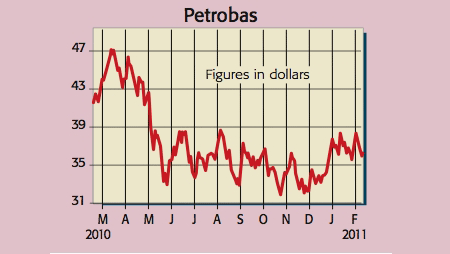
As a result of the Egyptian crisis, overseas investors have quit the Brazilian stockmarket in droves – Brazil’s Bovespa index shed 6% in the past month alone. This is odd, because with all its natural resources, higher oil prices should be positive. Indeed, out-going President Lula da Silva believes Brazil will become the world’s fifth-largest economy by 2016 (it’s currently eighth). The IMF predicts growth of 4.5% per year for the next two years. So where does this leave Petrobras, one of the top three integrated oil majors?
The energy giant has gargantuan resources in upstream exploration, downstream refining and, to a lesser extent, in gas, biofuels and renewables. The only minor glitch is that it is controlled by the government (53.6% of voting rights). And it is planning to spend $224bn in capital between 2010-2014 to develop its enormous hydrocarbon deposits, principally in the deep (50%) or ultra-deep (32%) waters off the coast of Brazil (eg, the Santos Basin).
Petrobras owns proven (1P) reserves of 12.7 billion barrels of oil equivalent (BOE), representing 12.5 years production. It also boasts 17.5 billion BOE of probable reserves (2P) – and that ignores vast acreage that hasn’t yet been drilled. Last September it had to raise $70bn in the largest corporate placing ever to help finance such rapid expansion. The remaining $154bn is set to come from internal cash flows (post dividends), assuming crude averages over $80 per barrel. The board’s goal is to double output from 2.7 million to 5.4 million BOE per day by 2020 – the fastest growth rate of any global major at 7.1% per year. This will entail converting eight oil tankers into floating production platforms, installing 500 underwater wells and buying a huge fleet of ships.
Petrobras (NYSE: PBR), rated OVERWEIGHT by HSBC
Such an engineering feat isn’t without risk, especially as most of the oil lies in the open sea 300km from Rio de Janeiro, under 2km of ocean and another 2km of salt. Fortunately, Petrobras has plenty of experience. It is already the world’s leading offshore producer and is confident it can lift the output at an average price of $45/barrel. That leaves lots of wiggle-room in the event of a market pullback.
Indeed, with Brent crude bubbling around $100/barrel, it seems stockholders could be in for a bumper payoff. After deducting net debt of $33bn (equating to 16% gearing) and valuing its 1P and 2P reserves at $15 and $7/barrel respectively, I estimate Petrobras’ ADRs are worth about $45 each.
Investors have a choice about what to buy. The ADRs (= 2 shares) are listed on the NYSE in both ‘ordinary voting (NYSE: PBR) and ‘preferred non-voting’ forms (NYSE: PBR-A), at prices of $36.50 and $32.50. However, the preferred form (or ‘prefs’), which are 10% cheaper, also rate as a buy, although they could be seen as slightly riskier due to their reduced shareholder powers. Both are very liquid and receive the same dividends, offering a yield of around 2%. I’d opt for the more expensive ordinary ADR, as this confers the right to vote at an AGM.
So what could blow this behemoth off course? Well, in line with the rest of the sector, Petrobras is exposed to volatile oil prices, fluctuating refining margins, rising costs (eg, steel) and foreign currency movements. Along with these factors, it has specific risks, such as possible government interference, that could affect minority shareholders, as well as the challenge of pulling off one of the hardest exploration programmes in history. All the same, if you’re looking for emerging-market exposure, then Petrobras fits the bill. HSBC has a target price of $50/ADR with prelims out on 25 February.
Recommendation: BUY at $37.50
• Paul Hill also writes a weekly share-tipping newsletter, Precision Guided Investments